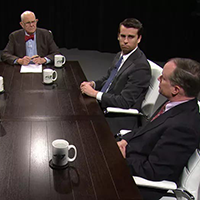High concerns in higher ed
Published October 2, 2025
By Tom Campbell
Folks in higher education must feel General Custer at Little Big Horn, fired at from almost every angle. Higher education hasn’t faced this many pressures in our lifetimes.
Nowhere is that stress greater than from the federal government. Colleges and universities have bullseyes pasted on them by the Trump administration, which hates Diversity, Equity and Inclusion programs, condemns affirmative action admission preferences, deplores antisemitism protests, claims ideological student indoctrination and their refusal to hear conservative voices.
Trump has taken aim at areas he can control - the flow of federal funding. Harvard had $2.6 billion in research grants frozen. Cornell had $1billion, Columbia $400 million and the list spreads like a spider web.
North Carolina schools are also affected. Duke reportedly had $108 million frozen. According to The Center for American Progress college cuts ranged from a low of $37,500 at NC Wesleyan to $40.2 million at UNC Chapel Hill, including $9.5 million at NC State, $5.9 million at High Point University, $4,373 million at UNC Charlotte, and $1.128 million at East Carolina. Jobs have been lost, research abandoned, innovations unrealized and foreign research students stripped of VISAs.
It's not just the federal government cuts keeping administrators awake. The new fiscal year for the state started July 1 without a new state budget, meaning state supported schools saw no enrollment growth funds, performance growth, salary increases, building reserve increases and no new capital budgets. If the projections by the Office of Management and Budget and the Fiscal Research Division of the legislature are accurate, the state is facing a budget deficit of $100 million or more this year. When a new budget is finally passed it is highly likely to include budget cuts…and higher ed will be a target.
Chancellors at UNC Chapel Hill and East Carolina are good at reading trends. ECU Chancellor Philip Rogers recently said, “We are not in a budget crisis right now,” but added there is the possibility for budget tightening down the road. UNC System universities froze tuition rates in 2016 and that freeze is adding to financial pressures on schools. ECU announced budget cuts of $25 million and Chapel Hill has made cuts of $70 million in anticipation. We applaud their prudent visionary leadership and financial accountability. Other schools are likely to follow.
At the same moment, administrators are preparing for another “cliff,” a demographic cliff. The National Center for Educational Statistics reports that enrollments in colleges and universities peaked at around18 million in 2010, but declined to 15.4 million in 2022, a 15 percent reduction. America’s birthrate has reached an all-time low of 1.6 children per woman and next year we will see the full impact of this cliff; for the first time the number of college age people will decline. Enrollment declines will follow.
Further, the average graduate has $38,700 in debt, according to the Education Data Initiative, causing more students to weigh the cost/benefit proposition. If you include tuition, fees, housing, food, books and minimal personal expenses, the average cost for attending our state-supported universities ranges from $27,000 to $32,000 per year; for private schools the average is reportedly $58,000.
A growing number believe a diploma isn’t essential. In 2010, 75 percent said a degree was important. By 2019 that number had shrunk to 53 percent. A Gallup poll released in September reported only 35 percent say a college education is very important; 30 percent said it wasn’t worth it.
In 2024, two dozen colleges closed their doors in the U.S. They were mostly private schools and located predominantly in the Northeast where populations are declining. Black Mountain College, Flora MacDonald, St. Andrews and St. Augustine’s are a few that have closed recently in North Carolina and the announced “merger” between Queens and Elon University was due to Queen’s declining enrollment (1,100) and large debt. Some private colleges are just barely hanging on.
Government cuts, enrollment declines, frozen tuitions, fewer prospects and the lessening of public value are highly problematic, but there are greater worries yet to come.
According to Carolina Demography, 18 percent of our state’s population is now over 65, having risen from 13 percent over 15 years. It is projected to be more than 20 percent by 2035.
This aging population will require more and more expensive healthcare and benefits like Medicare, Medicaid and Social Security and demand increased amenities. These boomers have changed every era since their birth and that is likely to continue. Besides, older people vote in greater percentages than all other age groups and can determine election outcomes.
Look for greatly increased demands on government, since most Boomers haven’t planned adequately for old age. Where is the money going to come from to fund these increased demands. There are only 3 choices: budget reallocations, increased taxes or reduced benefits. Higher education will be affected.
Perhaps now you can understand why those in higher ed are highly concerned.
Tom Campbell is a Hall of Fame North Carolina broadcaster and columnist who has covered North Carolina public policy issues since 1965. Contact him at tomcamp@carolinabroadcasting.com







